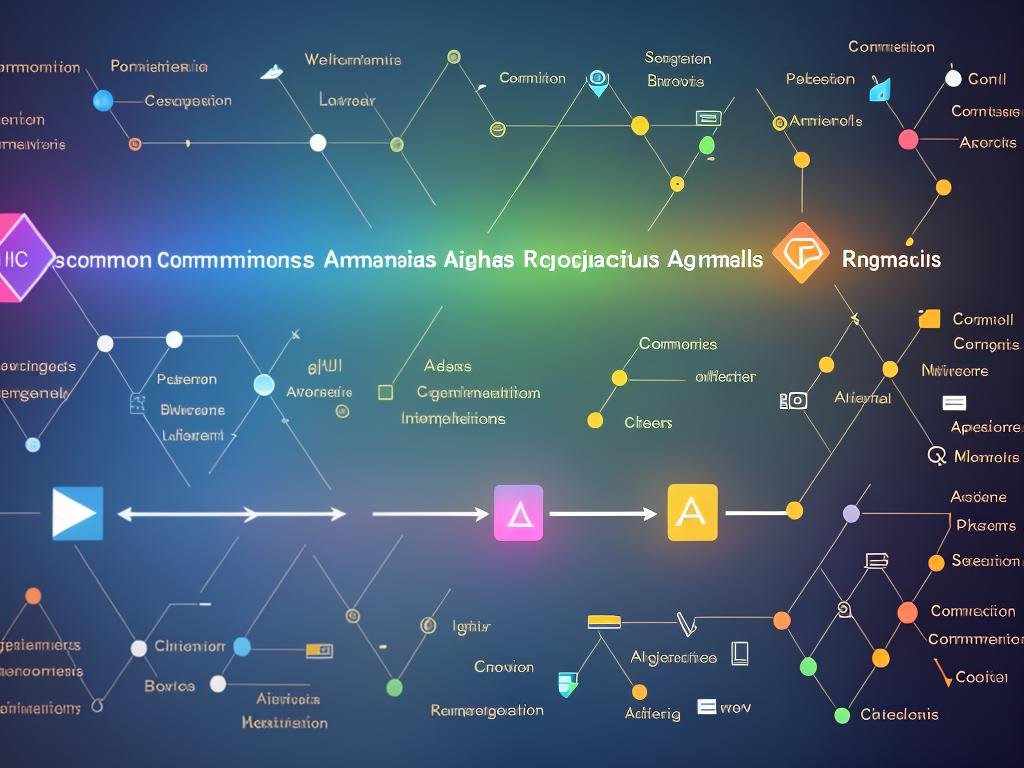Intertwined with our daily digital interactions, algorithm development plays a paramount role in the progressive evolution of computer science. These coded instructions, known as algorithms, aid in translating complex human tasks into a language that computers can understand and execute. This paper imparts a detailed exploration of the fundamentals of algorithms, the step-by-step process of their development, an overview of some common algorithms with their varied applications, and the potential challenges encountered with solutions to mitigate these issues. Lastly, we will prospect the future of algorithm development, delving into the upcoming advancements that largely involve machine learning and artificial intelligence.
Fundamentals of Algorithms
Definition and Characteristics of Algorithms
Algorithms are fundamental to computer science and programming. At their core, algorithms are step-by-step sets of operations that computer programs use to carry out tasks. These tasks can range from simple calculations to complex problem-solving.
An algorithm should possess certain characteristics to be effective. It should be precise, unambiguous, and clearly stated. As a finite set of fact-based instructions, it must also be consistent, meaning it produces the same result with the same input.
Furthermore, the algorithm should possess wisdom, meaning it should effective and efficient in its operation, delivering the output in the optimum time frame with minimum resource consumption. Lastly, an algorithm should be versatile and general enough to solve a broad set of related problems, and not just a specific case.
Types of Algorithms
Algorithms come in various types, based on the approach they use to solve a given problem:
- Divide and Conquer: It breaks a problem down into smaller sub-problems and solves each one independently.
- Dynamic Programming: This type of algorithm solves complex problems by breaking them down into simpler, overlapping sub-problems.
- Greedy Algorithm: It makes the best optimal choice at each decision point with the hope that these local solutions will lead to a global solution.
- Randomized Algorithms: These algorithms use a random number at least once during the computation to make decisions.
- Brute Force: It solves the problem by trying every possible solution until it finds the best one.
- Backtracking Algorithms: They are often used for optimization problems and reject solutions that aren’t viable.
Algorithm Efficiency
Efficiency is a critical aspect of algorithm development. It relates to the amount of resources an algorithm requires to solve a problem, including time and memory. To measure an algorithm’s efficiency, we often use ‘Big O’ notation, which categorizes algorithms based on how their run-time or space requirements grow as the input size increases.
Efficient algorithms are ones that can solve problems in the fastest time with the least amount of resources, even as the size of the input increases.
Algorithm Development: A Critical Component of Computer Science
As the bedrock of computer science and software development, algorithms have an instrumental role in computational progress and data processing. Acting as a roadmap for software actions, they enable the design and execution of programs that not only carry out complicated tasks with ease but also support data analysis, system optimization, and even the advent of artificial intelligence features. It can be said without a doubt that the understanding, design and practical implementation of algorithms are an essential aptitude in the field of computer science.

Steps in Algorithm Development
Understanding the Problem: The Base of Algorithm Development
The initial phase of algorithm development emphasizes decoding the underlying issue or challenge that the algorithm needs to resolve. Considering the problem holistically – inclusive of the nature and range – is crucial. Attention must be directed towards understanding the types of inputs required and the anticipated correct output. Take, for instance, the design of an algorithm meant to predict weather. The data to be inputted could include factors like air pressure, humidity, and temperature while the anticipated output might be predictions such as sunny, rainy, or snowy conditions.
Designing the Algorithm: Blueprint of Solution
After fully grasping the problem, the next task is to design the algorithm accordingly. This requires mapping out the steps the algorithm must follow to generate the desired output from the given input or to solve the set problem. For example, consider an algorithm designed to find the shortest route for a delivery. The algorithm should be designed to account for factors such as distance between locations, traffic conditions, and known obstacles to come up with an optimal route.
Coding: Translating the Blueprint into Language Computers Understand
Subsequently, the designed algorithm is coded or translated into a computer-friendly language. Depending upon the nature of the problem and algorithm, programming languages like Python, JavaScript, C++, and R may be used. For the above-mentioned routing problem, the algorithm could be coded using Python’s powerful data analysis libraries like Pandas and NumPy.
Testing: Assuring Effectiveness of the Solution
Once coded, the algorithm is tested under different scenarios and circumstances. The developer feeds different inputs to test the reliability and accuracy of the algorithmic output. The weather prediction algorithm mentioned earlier should be tested with various combinations of air pressure, humidity levels, and temperatures. Based on these tests, the algorithm should predict weather conditions accurately in the majority of instances.
Maintenance: Ensuring the Longevity of the Algorithm
Nevertheless, the algorithm development process doesn’t end with successful testing. The algorithm should undergo periodic checking and updating to ensure its efficiency and relevancy over time. Seasonal changes, for example, could impact the accuracy of the weather prediction algorithm, requiring modifications to adapt to these changes.
Algorithm development, at its heart, is a combination of innovation and problem-solving. It’s a complex and systematic process that, when understood and implemented correctly, opens up the possibility of creating robust, efficient, and context-specific algorithms.

Common Algorithms and their Applications
Digging Into Commonly Used Algorithms
At its core, algorithm development revolves around designing step-by-step instructions or sets of rules to compute calculations or solve problems. These guidelines prove to be crucial in numerous fields such as computer sciences, mathematics, and data handling. While the world of algorithms is vast, we’ll narrow our focus to some prevalent types. These include sorting algorithms, searching algorithms, and cryptographic algorithms.
Sorting Algorithms and Their Applications
Sorting algorithms are essential for organizing data in a specific order. These algorithms are fundamental in database systems where data must be fetched fast and efficiently. They hold a considerable impact on factors such as speed, memory consumption, and computing power of a system. Some examples of sorting algorithms include bubble sort, selection sort, merge sort, and quick sort.
Bubble sort, for instance, repeatedly steps through the list comparing each pair of adjacent elements and swapping them if they are in the wrong order. On the other hand, quick sort divides the list into smaller parts based on a “pivot” element chosen from the list.
These sorts of algorithms are widely used in fields like e-commerce, where products need to be organized according to different attributes like price, ratings, or brands.
Searching Algorithms and Their Applications
Searching algorithms are used to find a specific item from a collection of items. These algorithms are beneficial in different aspects of the digital realm. From online search engines, to locating specific files or documents within a database, these algorithms play a crucial role.
Some typical examples of searching algorithms are the linear search and binary search. Linear search works by sequentially checking each element until a match is found or the whole list has been searched. Binary search, however, works by halving the search space with each step until the search item is found.
Cryptographic algorithms and their Applications
Cryptographic algorithms are the cornerstone of data security in the digital world. Cryptography involves the process of converting ordinary plain text into unintelligible text and vice-versa.
This is vital to secure communication as it helps prevent sensitive information from being accessed by unauthorized individuals. The applications of cryptographic algorithms are vast and can generally be seen in fields that require the protection of information such as cybersecurity, financial organizations, healthcare, among others.
Some common examples of cryptographic algorithms include symmetric algorithms (e.g. DES, AES) which use the same key for encryption and decryption, and asymmetric algorithms (e.g. RSA, DSA) that use different keys for encryption and decryption.
Understanding Algorithm Development
In the fast-paced world of technology, the fundamental role of algorithm development is becoming increasingly significant. Algorithms, which aid in sorting and analyzing data and enhancing our digital communication, have cemented their position as an indispensable tool in our modern world.

Challenges and Solutions in Algorithm Development
Addressing Efficiency in Algorithm Development
Nevertheless, algorithm development is not without its own set of challenges. Primary among these is the issue of efficiency, centered around the time and space complexity of the code. This essentially refers to the computer resources necessary for the execution of the algorithm. An inefficient algorithm can excessively consume resources and decrease speed, especially when working with large data sets, potentially causing significant system delays.
To avoid these problems, it’s vital for developers to plan and test their algorithms meticulously. Utilizing strategies such as dynamic programming for optimization and data structures like hash tables for rapid access can significantly contribute towards developing efficient algorithms.
Difficulty Ensuring Algorithm Accuracy
Algorithm accuracy is another challenge in its development. This means that an algorithm correctly implements the desired functionality and produces correct results for all possible inputs. Ensuring accuracy poses a challenge as it often involves managing complex logic and handling a wide variety of edge cases.
The solution to this involves rigorous testing, code reviews, and sometimes the use of formal verification methods. A well-tested, peer-reviewed algorithm is much more likely to be accurate and reliable.
Maintaining Readability and Scalability
Readability refers to how easily other developers can understand the algorithm, while scalability refers to how well the algorithm handles increasing data. Both are vital for the long-term maintenance and usefulness of an algorithm.
To enhance readability, developers should follow best coding practices, including writing meaningful comments, utilizing consistent naming conventions, and employing a clear and simple structure. For scalability, developers should prefer algorithms with lower time and space complexity, favoring linear or logarithmic time complexity over polynomial or exponential.
The Problem of Algorithm Bias
Algorithms can sometimes reflect or even amplify societal biases and inequalities, especially when they are based on biased training data. Such algorithmic biases could lead to unfair outcomes and even significant legal and ethical concerns.
To address algorithmic bias, developers should adopt a fair and transparent approach to algorithm development. This could include using a diverse and representative dataset for training, testing the algorithm against various demographic groups, and subjecting the algorithm to third-party audits for bias.
Adapting to Changing Business Requirements
Algorithms, like any technology, need to adapt to changing business requirements and environments. A well-designed algorithm today may become obsolete tomorrow if it fails to adapt.
Hence, it is essential to follow agile software development principles, which could help make algorithms more adaptable. Regularly revisiting and updating algorithms based on feedback and changing requirements can ensure that they remain relevant and effective.
Understanding Algorithmic Complexity: Navigating the ‘Curse of Dimensionality’
Often in computer science and data analysis, we encounter the ‘curse of dimensionality’. This term refers to the steep rise in computational complexity that occurs when the number of dimensions (variables or features) in a data set increases. This exponential amplification often presents a stumbling block while developing optimal machine learning or data mining algorithms.
However, several methods have been devised to circumvent this ‘curse’. Techniques aimed at reducing dimensionality, for instance, Principal Component Analysis (PCA) or feature selection methods, can greatly streamline complex, high-dimensional data. Additionally, algorithms based on tree structures or cluster configurations can also capably manage high-dimensional data by dissecting the problem into smaller, more tractable segments.

Futuristic Trends in Algorithm Development
Looking Ahead: The Exciting Future of Algorithm Development
Algorithm development stands as a fundamental pillar within the expansive field of computer science. It involves the design and application of ordered steps to solve problems or execute tasks. The landscape of this domain is constantly evolving due to advancements in technology. Modern developments in machine learning and artificial intelligence (AI) have significantly altered the nature of algorithm development, driving greater efficiency and opening new avenues for exploration and innovation.
Machine Learning in Algorithm Development
Machine learning is a subfield of AI that emphasizes the creation of systems that learn and improve from experience. In algorithm development, machine learning presents a promising trend by automating the creation of complex algorithms. Instead of manually designing and updating algorithms, developers create algorithms whose underlying principles learn from data, improving their effectiveness over time.
Artificial Intelligence in Algorithm Development
Artificial intelligence’s scope extends beyond just machine learning. It involves developing systems capable of performing tasks that usually require human intelligence, such as speech recognition and decision-making. In algorithm development, AI can facilitate the development of more efficient and innovative solutions. For instance, AI techniques can help in devising algorithms that detect unusual patterns in large datasets – a task that would be practically impossible for humans due to the involved computational complexity.
Automated Algorithm Design
As a futuristic trend, the idea of automated algorithm design is gaining traction. This practice uses machine learning and AI to create algorithms that are not only self-tuned and self-improving but can also design themselves from scratch. Automated algorithm design promises to revolutionize the field by making algorithm development more efficient, versatile, and adaptable to complex problem-solving scenarios.
Quantum Algorithms
Another future trend to watch out for is quantum algorithms. These are algorithms that run on quantum computers, devices that leverage quantum mechanics’ complex phenomena to perform computation. Quantum algorithms hold the potential to solve problems much faster and more efficiently than their classical counterparts, especially for tasks involving large-scale computation or the analysis of enormous datasets.
Ethics and Fairness in Algorithm Development
As the field of algorithm development advances, the issue of ethics and fairness is increasingly coming to the fore. Developers are now tasked with not only creating effective and efficient algorithms but also ensuring that they are fair and don’t perpetuate or amplify societal biases. In the future, we can expect this trend to gain even more importance, driving the creation of algorithms that are both high-performing and socially responsible.
The incorporation of these futuristic trends in algorithm development will revolutionize the way we create, implement, and utilize algorithms in various fields, from finance and healthcare to entertainment and security. These developments underline the importance of continual learning and adaptation in the face of technological advancement.

Throughout this discourse, we’ve aptly established an understanding that algorithms are a cornerstone in the realm of computer science. Their significance and diverse applications testify to their immense potential and the vast opportunities that lie ahead in algorithm development, especially with the incorporation of new trends like AI and machine learning. As we continue to race forward in the digital age, one can anticipate the relentless evolution of algorithms and the exciting breakthroughs that they’re poised to introduce, thus making the field of computer science and the world at large a more efficient, innovative, and technologically-driven sphere.



